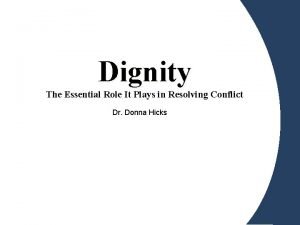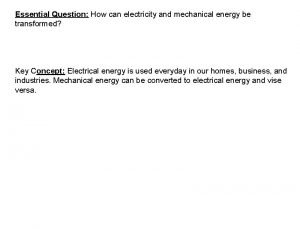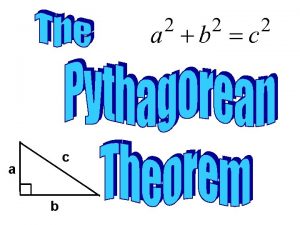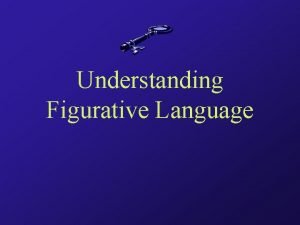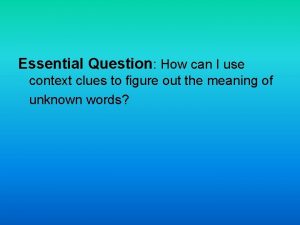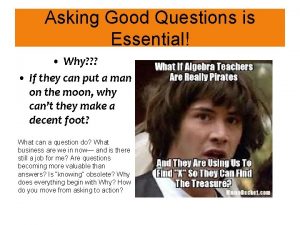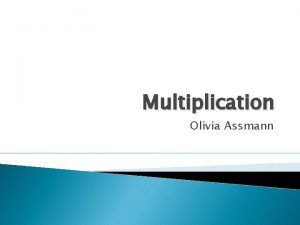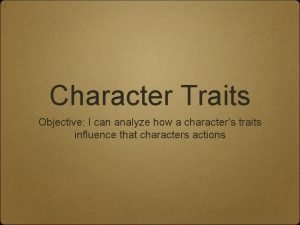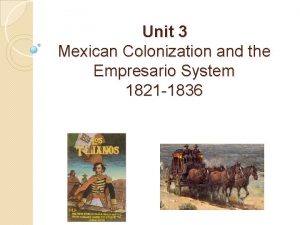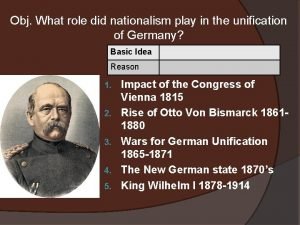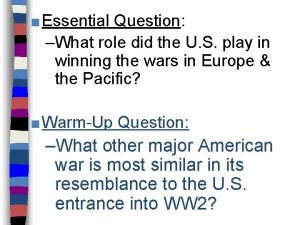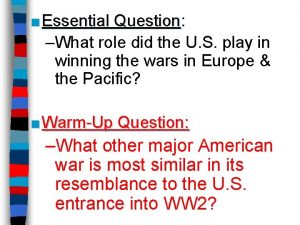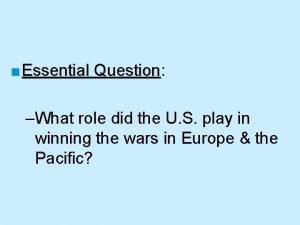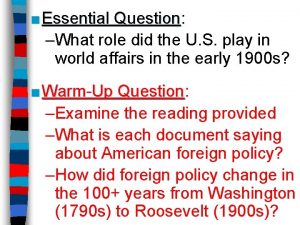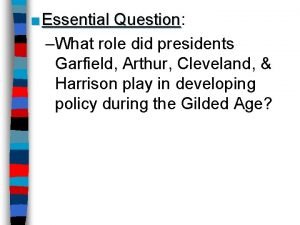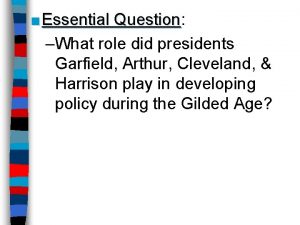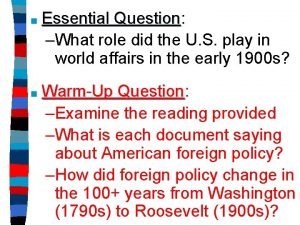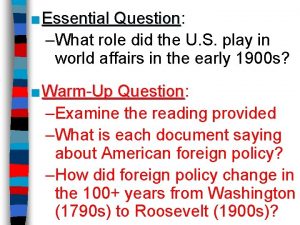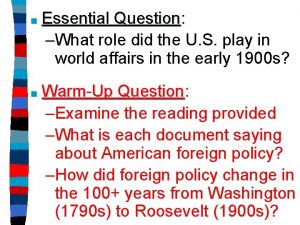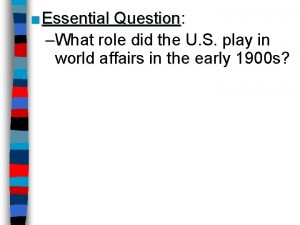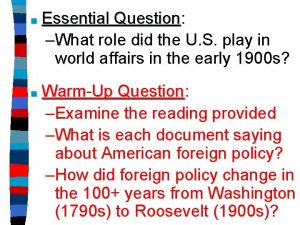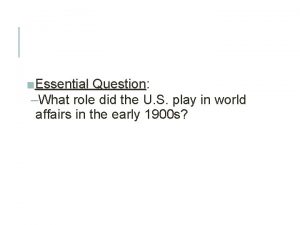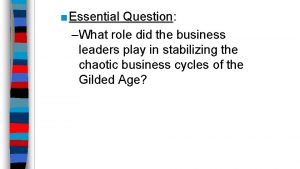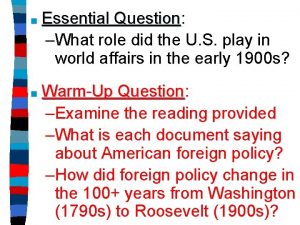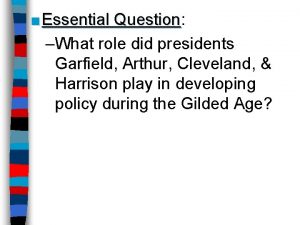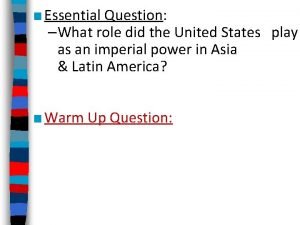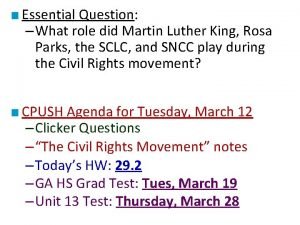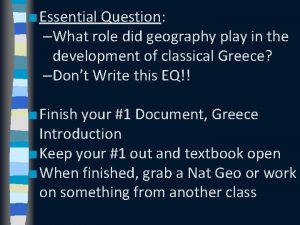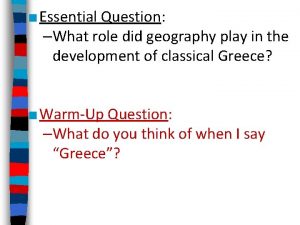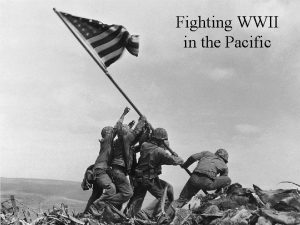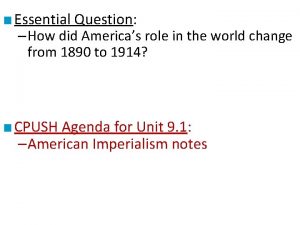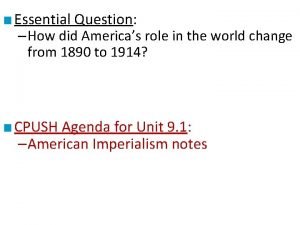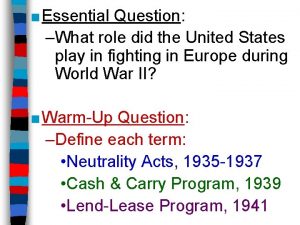Essential Question Question What role did the U

























- Slides: 25

■ Essential Question: Question –What role did the U. S. play in winning the wars in Europe & the Pacific? ■ Warm-Up Question: –What other major American war is most similar in its resemblance to the U. S. entrance into WW 2?

When the U. S. entered WW 2 in late 1941, Japan dominated Germany controlled the western half of almost all ofvictory Europeseemed remote the Pacific Ocean Germany pressed into Russia Axis armies controlled Northern Africa & threatened But…over the next 2 years, the U. S. & the Allies Suezto. Canal began win the wars in Europe & the Pacific

Europe 1941 -1943 The U. S. wanted to attack across Nazi-controlled France by 1943 The USSR “freed” Poland, England. Hungary, wanted to. Romania attack Italy from In 1942, troops To U. S. -Anglo win the European In 1943, Africa the Soviet armycampaign, won. Italian at Stalingrad; Northern in began the 2 campaign different Germany again on was the offensive 1942 was never & Stalin ANGRY plans were proposed

The Allies began to win the Battle of the Atlantic in 1941 with Lend-Lease aid, but took control in 1943 with America’s entry into the war

Tehran Conference, 1943 By agreeing to “Operation Overlord” (D In-Day), 1943, Churchill, Stalin met FDR■proposed a FDR, future dominated the Allies. United would. Nations divide the Axis by “ 4 in policemen” (USA, Britain, USSR) Tehran, Iranacross for the first of&three military two. China, fronts with power to “deal immediately with any sudden wartime conferences: emergency which requires action” –The USA, Britain, USSR coordinated their war strategy –FDR & Churchill finally committed to Stalin’s demands to open a western front (D-Day) –Discussed plans to create a “general internat’l organization” to promote “peace & security” (UN)

Europe 1944 -1945 U. S. & British troops landed at 5 strategic points, pushed through France drove towards Germany The long-awaited 2 nd front came on June 6, 1944 with D-Day

Allied ingenuity helped win the war: U. S. Hedgerows in Normandy soldiers were trained to problem-solve rather than wait for orders

Yalta Conference in February 1945 ■ The. To“Big 3” met Yalta to & recognize theat independence discuss post-war given sovereignty of nations. Europe in Eastern Europe the eminent defeat of Germany: –Stalin refused to give up Eastern Europe but he did agree to “selfdetermination” –Stalin agreed to send Soviet troops to the Pacific after the German surrender if the USSR could keep Manchuria


Soon after the Yalta Conference in Feb 1945, FDR died…and Harry Truman became president

In late April 1945, the Allies broke through the Eastern & Western Fronts forcing both Italy & Germany to surrender

Europe 1944 -1945 1941 -1943

“Island-hopping” allowed the. Tokyo Allies on to win The Doolittle Raid on strategic islands without April 18, 1942 wasinvesting a morale precious boost time, resources, & American lives U. S. victory at Midway in 1942 gave the Allies naval supremacy

The Japanese refused to play according to the Geneva Convention “rules” of war

The German surrender in May 1945, allowed the U. S. to turn its full attention towards Japan Victories at Saipan in 1944 & Iwo Jima & Okinawa in 1945 allowed for bombings on Japan

The Decision to Drop the A-Bomb ■ With no definitive end it sight, how would the Allies defeat Japan? –The U. S. military favored a fullscale invasion of Tokyo by 1946 –The Japanese refused to surrender & were arming civilians for an Allied invasion –At the Potsdam Conference in July 1945, Truman gave the order to use the atomic bomb

■ Essential Question: Question –What role did the U. S. play in winning the wars in Europe & the Pacific? ■ Warm-Up Question: –What was the significance of: Lend-Lease, Atlantic Charter, Stalingrad, D-Day, Midway, Iwo Jima, Appeasement, Tehran, Yalta, Potsdam

Enrico Fermi at the University of Chicago (physicist who developed the nuclear reactor)

The Decision to Drop the Atomic Bomb Group Activity ■ How should President Truman bring an end to the Pacific theater of WW 2 in 1945? Now that we’ve heard from each “role, ” – Each student group be given a role: what are yourwill opinions? Was thisscientific, the correct decision? Explain civilian, military, diplomatic – From your role’s perspective, what Read “Truman’s Decision to Drop the Atomic possible exist to end theopinion? war? Bomb. ” Doesoptions this article change your What are the positive & negative consequences of each alternative? – What is your groups’ recommendation to President Truman to end the war? Why?

Triumph & Tragedy in the Pacific ■ In August 1945, the USA forced Japan to surrender by dropping 2 atomic bombs ■ Effect of the atomic bomb: –Saved hundreds of thousands of American (& Japanese) lives –Revenge for Pearl Harbor –Showed the USSR that the USA had the ultimate weapon (began the Cold War nuclear arms race)

Nagasaki Hiroshima


WW 2 Timeline (Allies, Axis, USSR)

Its Finally Over!

Conclusions ■ WW 2 was the largest & deadliest war in history & changed the U. S. –Wartime industry ended the Great Depression, expanded the size of the federal gov’t, & ushered in affluent decade –The USA emerged as a world superpower, developed a nuclear arsenal, & engaged a Cold War against the USSR
 Essential non essential fatty acids
Essential non essential fatty acids Costa level questions
Costa level questions Dignity its essential role in resolving conflict
Dignity its essential role in resolving conflict C# azure worker role example
C# azure worker role example Symbolischer interaktionismus krappmann
Symbolischer interaktionismus krappmann Statuses and their related roles determine
Statuses and their related roles determine Who is the author
Who is the author Tina ordered a replacement part for her desk
Tina ordered a replacement part for her desk Essential question generator
Essential question generator Essential questions for pythagorean theorem
Essential questions for pythagorean theorem Essential question for figurative language
Essential question for figurative language Individual vs society
Individual vs society Essential questions for context clues
Essential questions for context clues Cornell notes essential question
Cornell notes essential question Open ended questions examples
Open ended questions examples Essential question for multiplication
Essential question for multiplication Essential question gif
Essential question gif Objective traits
Objective traits What is the cornell way
What is the cornell way Essential questions about fear
Essential questions about fear What was the empresario system
What was the empresario system What role did nationalism play
What role did nationalism play What role did he play
What role did he play What role did the
What role did the What role did the
What role did the Hình ảnh bộ gõ cơ thể búng tay
Hình ảnh bộ gõ cơ thể búng tay


